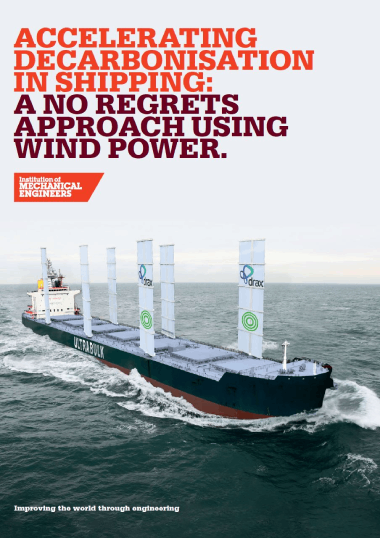Press Release: Fitting sails to cargo ships and sailing more slowly could reduce greenhouse gas emissions from the shipping industry by up to 40% or possibly more as technologies improve, according to a new report from the Institution of Mechanical Engineers.
Air pollution from shipping has increased rapidly over the last decade driven by growth in world trade, and as most emissions are from international shipping, they are not included in individual countries’ reduction targets.
The UK announced this week, however, it is to include international shipping in its new emissions targets.
If unchecked, shipping could account for as much as 20% of global emissions by 2050 compared with 3% today.
In its report “Accelerating Decarbonisation in Shipping: A No Regrets Approach Using Wind Power”, the Institution calls for the Government to support the development of a demonstration ship using retro-fitted sails to help ship owners and users understand the business case for how wind could be used as primary propulsion for cargo vessels
“We need to use existing and emerging technologies to urgently reduce the impact of our global supply chain on the environment. Continuing with the “business as usual” approach could result in shipping being responsible for up to a fifth of global emissions by 2050,” said Dr Jenifer Baxter, Chief Engineer at the Institution of Mechanical Engineers.
The Institution recently supported a feasibility study by Smart Green Shipping which showed the potential for reducing emissions on a ship retrofitted with fixed sails could be as much as 30% given the right conditions.
Slowing down improves fuel savings and thus cutting emissions.
The shipping industry is focused on developing alternative fuels such as hydrogen and ammonia to replace polluting bunker fuel, but these fuels will be at least three times more expensive and will not be ready for the shipping market for at least a decade. Using alternative fuels combined with wind power makes economic sense.
“Wind is free, clean, abundantly and exclusively available to ships equipped to harness it. It decouples ship owner/operators from volatile land-based commodity fuel supply, critical in an energy-constrained future – and, most importantly, has the capacity to drive emissions out of the shipping sector immediately,” said Diane Gilpin, founder and CEO of Smart Green Shipping.
Recent figures from the International Maritime Organisation (IMO) showed emissions rising by 10% between 2012 and 2018.
The shipping industry has limited plans to curb this growth. In November 2020, the IMO brokered an agreement with the majority of countries, including the UK, that would allow shipping to continue polluting unabated to 2030.
Read report here.

































